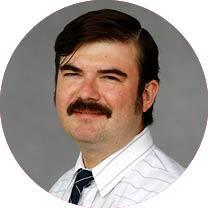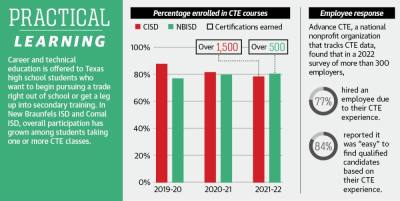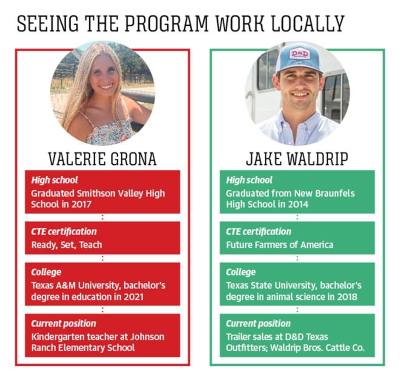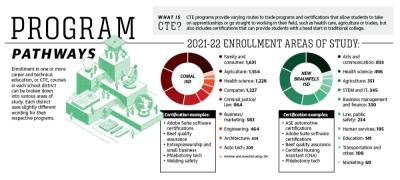Unlike traditional high school courses, these programs provide a more technical knowledge base for specific professional fields and practical training and certification that helps students hone in on specializations earlier in their careers, according to the Texas Education Agency.
Rachel Behnke, director of CTE programs at NBISD, said Texas as a whole has been pushing for districts to develop these programs in recent years.
“The Texas Education Agency developed these programs of study. In school districts, we made them applicable to our local courses in what we offer,” Behnke said. “The intent there is to kind of have multiple entry and exit points. So for example, if a student went through a program at high school and decided they want to go directly to work, they could go into that position. Or if a student wanted to keep furthering their education, they already have a leg up in a career route.”
A variety of state and federal funding is available to school districts for these programs through the continued reauthorization of the Carl Perkins Career and Technical Education Act of 2006, most recently reauthorized by Congress in 2018, according to the U.S. Department of Education.
State and federal funding is then allocated by the TEA based on local needs assessments submitted by school districts that gather data on local economic considerations, jobs available and student needs.
Advance CTE, a national nonprofit organization that represents state directors of CTE education and tracks data, found that in a 2022 survey of more than 300 employers, 77% hired an employee due to their CTE experience, and 84% reported it was “easy” to find qualified candidates based on their CTE experience.
In the most recent school year, students in NBISD earned more than 500 certifications, and in CISD students earned over 1,500.
“We’re trying to increase the number of industry certifications that are available to students. Those are really prevalent in health science,” Behnke said.
Renee Martinez, director of career readiness in CISD, said the programs have grown partly because they are not monolithic, but instead offer several degrees of involvement—from clear sequences of courses throughout high school to students electing to take a course or two out of interest.
“CTE covers a lot of areas. If you have a kid that’s not in band, choir or athletics, their only other elective options fall in CTE, and even then you might have a kid that’s involved in one of these programs randomly taking a CTE class [such as] accounting or principles of health science,” Martinez said.
CISD offers more than 140 CTE courses throughout the district, and within those there are 35 programs of study that students can pursue through high school.
In NBISD there are more than 80 courses and 20 programs of study.
Career pathways
The specialization of CTE programs provides for a variety of paths into the workforce, and many students find themselves employed in their field of choice directly out of high school. Others use their experience to guide them down a path they might not have fully figured out while in high school, but the programs give them a leg up in finding the right career, according to the program directors at NBISD and CISD.
“Some kids come into my classroom having no idea what they want to do,” said Jennifer Thompson, a CTE teacher at New Braunfels High School who teaches courses in criminal justice, law enforcement, public safety, forensic science and other related courses. “They realized I don’t just focus on law enforcement. There’s other things in the criminal justice field that they could do. So it kind of gives them a brighter perspective of what they could actually do with their degree if they go into criminal justice.”
Thompson added that through her sequences of classes, former students have gone on to all aspects of law enforcement, such as working as a 911 dispatcher while studying criminal justice at Texas State University as well as several who became military police.
Jake Waldrip, a 2014 graduate of New Braunfels High School, said he always knew he would pursue a career in agriculture, and through the Future Farmers of America programs he had shown cattle since he was a child. He graduated from Texas State with a degree in animal science and now works for both his family’s business—Waldrip Bros. Cattle Co.—and in livestock trailer sales at D&D Texas Outfitters.
While Waldrip grew up in the trade, he said many students took some of the agriculture classes with him without any background.
“I had high school friends that didn’t grow up around it necessarily, and they showed some other species, but they would come and help us with the show cattle throughout the whole process ... as much as in depth as they wanted to get into, we were always willing to help and always had open arms,” Waldrip said. “So long as somebody is willing to show up and get their hands dirty and work hard, there’s a ton of people that are willing to teach and get kids involved in all aspects of the game.”
Mike Newkirk, an automotive tech teacher at Canyon High School, said some of his students go directly into the industry while others pursue postsecondary work in the field.
His students typically go through four years of automotive tech, from basic principles of the mechanics of cars to more advanced coursework. His classroom also serves as an auto shop for teachers and staff to bring their own parts and have the students work on their vehicles.
“I put them to work straight after school if they don’t want to go to postsecondary or college or you know if they want to do something else in life,” Newkirk said. “If they don’t want to go to college, I have industry leaders here [at] local dealerships from San Antonio to South Austin that will hire my guys as they come out of my program because we are accredited.”
One of those recent graduates is James Robinson, who received a scholarship to UTI but chose instead to go right to work at Griffith Ford.
“Mr. Newkirk gave me the opportunity to get every certification I could at my age. I came out of the Canyon High School automotive program with over 20 certifications,” Robinson said.
“I wanted to just make money immediately; I didn’t want to have to owe it. So I decided that rather than having to wait to start my career and start at the bottom, I can start at the bottom now rather than in four years,” he said.
Careers in college
CTE pathways also provide a door into fields that allow students to work within the field they are pursuing a higher degree in to gain experience.
Sanjay Patel graduated from NBHS in 2016, and while in school knew he wanted to be in the medical field and took pre-dental coursework.
“I was aspiring to be a dentist, [but] I realized that dentistry is not where I want to be. I still knew I wanted to be somewhere in the health care field, and that’s when I started exploring what the different options I had in health care. I started looking toward administration,” Patel said.
After earning a bachelor’s degree in public health from the University of Texas at San Antonio and a master’s in business, he is now interning at a hospital in Carrollton.
The CTE course he took on medical terminology was also helpful, he said.
“[It helped] me learn more about the terminology that medical practices often use. I’d say the practicum course helped me out a lot. Close to my junior year and at the end of my junior year, I received my registered dental assistant certification. So during my senior year in high school, I was also working as a dental assistant in the office while doing school,” he said.
For students looking to enter the teaching profession, CTE programs such as Ready, Set Teach place high school students in a classroom a few hours a week to learn from current teachers and interact with students.
“I had kind of always known that I wanted to work with kids, but I wasn’t full-on sure if it was teaching I wanted to do, so I joined it my junior year, and I got to be in a classroom four days a week for two hours,” said Valerie Grona, a 2017 graduate of Smithson Valley High School and now a kindergarten teacher at Johnson Ranch Elementary School.
Grona said the experience showed her what being a teacher is all about and affirmed her interest in pursuing teaching as a career.
While participating in the Ready, Set Teach program, Grona was able to work at the elementary school she went to and now teaches in.
“That kind of came full circle for me,” she said “But really, it just kind of showed me what teachers do every single day and gave me a taste of it. It’s probably one of my most memorable things of high school was being ready to teach because it was the thing I looked forward to every day.”








